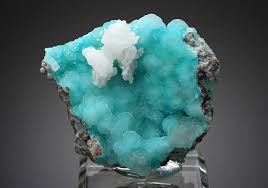
Smithsonite: The Soft-Hearted Healer of the Mineral Kingdom
A Delicate Treasure in the World of Raw Crystals
Amid the bold brilliance of tourmalines and the geometrical drama of quartz clusters, Smithsonite offers a gentle counterpoint — a crystal of tenderness, heart healing, and quiet resilience. Revered by collectors for its velvety lustre and subtle colour palette, and cherished by metaphysical seekers for its emotional comfort, Smithsonite embodies beauty in softness. For those drawn to raw crystal jewellery or the art of mineral specimen adornment, this mineral provides a nuanced and deeply soulful expression.

Geological Composition & Origin
Smithsonite is a zinc carbonate mineral (ZnCO₃), typically forming in botryoidal (grape-like) masses or globular crusts with a pearly to silky lustre. It belongs to the carbonate class and often appears in gentle pastel hues, including:
-
Lilac
-
Pale blue-green
-
Soft pink
-
Apple green
-
Yellow or beige
The colour variations are typically caused by trace elements — cobalt for pinks, copper for blues, and cadmium for yellows. Its Mohs hardness ranges from 4 to 4.5, making it relatively soft and requiring care in wear.
Key Locations:
-
Namibia (notably Tsumeb)
-
Mexico (Chihuahua)
-
United States (New Mexico and Colorado)
-
Greece, Italy, and occasionally Australia
Despite its delicate nature, Smithsonite is a favourite among collectors for its undulating forms and soothing chromatics, especially when preserved in its unpolished, natural form.
Energetic Significance & Healing Properties
Smithsonite is often called the "stone of emotional rebirth." Unlike stones that energise or shield, it soothes, comforts, and mends. Its vibrational tone aligns particularly with the heart chakra, encouraging the release of:
-
Emotional trauma
-
Deep-seated grief
-
Feelings of inadequacy or abandonment
It invites users to self-soothe and rekindle inner gentleness. Its soft frequencies make it ideal for:
-
Children, or those experiencing inner child healing
-
Highly sensitive individuals (empaths, intuitives)
-
Anyone navigating transitional life phases (grief, separation, identity change)
Smithsonite is also said to encourage diplomacy, aiding communication that is both truthful and tactful — particularly helpful in relationship healing or family mediation.
Collectible Qualities & Natural Form
The mineral’s botryoidal surface and waxy translucence are hallmarks of quality Smithsonite. Unlike faceted gemstones, Smithsonite’s value lies in its natural geometry and colour purity — the more luminous, the more prized.
Collectors often seek out:
-
Undamaged botryoidal clusters
-
Unusual colourations (e.g., intense blue or vibrant pink)
-
Well-formed mineral pairings (Smithsonite with calcite, aragonite, or cerussite)
In its raw state, Smithsonite communicates a quiet elegance — the kind of piece that glows softly on a display shelf or becomes a meditative companion.
Smithsonite Compared with Other Healing Crystals
In terms of emotional energy, Smithsonite is often compared with Rose Quartz and Lepidolite — all gentle stones associated with healing the heart. However, Smithsonite differs in subtle ways:
-
Rose Quartz fosters unconditional love; Smithsonite nurtures wounded self-worth and helps process grief.
-
Lepidolite, rich in lithium, aids anxiety and mood stability; Smithsonite focuses more on emotional resilience and tenderness.
-
Compared to Chrysoprase, which energises and inspires hope, Smithsonite operates at a quieter, more introspective frequency.
It complements grounding stones like Smoky Quartz or Black Tourmaline, creating a synergy between emotional healing and energetic protection.

Smithsonite in Jewellery — Embracing Its Raw Beauty
Due to its softness, Smithsonite is not commonly cut into traditional faceted stones. However, in the realm of mineral specimen jewellery, its unique surface texture and gentle hues lend themselves exquisitely to raw designs.
In handmade adornments, Smithsonite may appear in:
-
Crystal specimen rings, where small, domed pieces are showcased with minimal interference
-
Mineral specimen necklaces, particularly when paired with protective metals like oxidised silver or bronze
-
Cabochon pendants, set in protective bezels to shield the surface
Each piece honours the natural formation — ripples, veining, and colour zones remain untouched, letting Mother Earth’s design speak directly.
Artisan brands that focus on raw crystal jewellery and intuitive aesthetics — like our UK-based studio — value Smithsonite for both its beauty and emotional resonance.
Cultural Context & Mystical Lore
Smithsonite is not steeped in ancient mythology as some stones are, but it holds modern-day reverence in metaphysical circles. It’s sometimes called the "stone of kinder truths" — guiding wearers to reclaim softness without surrendering strength. Practitioners may place it on the heart during meditation, or wear it during reconciliation conversations to keep energy gentle and open.
Because of its tender associations, it’s often gifted during:
-
Bereavement or personal loss
-
Heartbreak and relational healing
-
Times of family reconnection or inner child therapy
A Final Thought: The Call of Quiet Stones
While bold crystals might command attention, Smithsonite calls to the soul in whispers. It reminds us that softness is not weakness, and vulnerability is a strength.
For those creating sacred adornments with purpose, Smithsonite becomes more than a stone — it becomes a gentle companion on one’s healing journey.